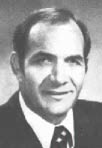Pilot to Navigator: Where Are We?
A creature from outer space could land in the U.S. and, without benefit of road signs, know exactly what city it was in because city names are almost always on water towers. The practice started a little more than 50 years ago after Charles Lindbergh made the world aviation conscious. He realized that people were flying by the seat of their pants with little more than compasses, personal geographical knowledge, and good luck to guide them. It was his idea that towns identify themselves by painting their names on water towers, and the idea has helped many lost pilots find their way to safe landings.
Emblazoning the town name on water towers is still a point of civic pride in many communities, but the original purpose is no longer valid. With accurate flight maps, radio compasses, radar, and other equipment, town names on water towers have become obsolete as navigational aids.
Two November 1984 articles in AJO point to a similar situation that exists in orthodontics today. The first article, by Skieller, Bjork, and Linde-Hansen,1 illustrates how a method that is 86 percent accurate can be used to predict the direction and amount of mandibular growth rotation in extreme cases. This is valuable information for the clinical orthodontist, and prediction of mandibular growth and rotation with such accuracy is an enormous leap in diagnostic capability.
How little we clinicians may recognize about the growth and rotation of the mandible was illustrated by Baumrind, Korn, and West2 in the second article. In an empirical test of mandibular rotation prediction, 64 patients who exhibited either extreme backward rotation or extreme forward rotation were evaluated by five anonymous expert judges whose mean clinical orthodontic experience was 28 years. There were three findings of great importance to orthodontists: (1) none of the experts predicted the forward or backward rotators with any more accuracy than chance alone might do; (2) there was strong evidence that the clinical experts used a shared--though relatively ineffective--set of rules in making their judgments; (3) the predictive power afforded by standard cephalometric measurements did not identify backward rotators at a rate significantly better than chance.
It seems to me that orthodontists today are like pilots of the Lindbergh era. When daylight weather is fine and we don't soar more than 5,000 feet above the ground, we can rely upon landmarks like those names on the water towers. But when we are asked to fly at night or make hazardous instrument landings, those town names become invisible and useless.
As long as we treat what Eb King calls the "so-what" cases, the Steiner, Downs, and Tweed analyses continue to give us some guidance. I've always thought the finest contribution of these great pioneers was that they brought a measure of understanding to what had previously been little more than voodoo orthodontics. And just like the towns that painted names on their water towers, they have made our orthodontic journeys much safer. But, like the water towers, our diagnostic aids have also become primitive guideposts. Baumrind, Korn, and West show that they fail to predict what growth might do and, in particular, what growth plus treatment might do to the facial appearances of our patients.
As the Baumrind article points out, perhaps our profession is too willing to stay at that primitive stage of development. Right now we should be advancing toward newer, more accurate, and more sophisticated diagnostic techniques that consider growth, treatment mechanics, and facial soft tissue. And as the Skieller article has shown, much of the information that can lead us into this new era is already known. What is lacking is a reasonable, understandable, and dependable system of diagnosis and treatment design that can be put into action by the clinical orthodontist.
Certainly some headway has been made toward this goal. Holdaway, Ricketts, Johnston, and Burstone are some of the leaders in the current struggle to find a more accurate and predictable diagnostic model for orthodontics. No doubt someone will eventually succeed in combining what we know about orthodontics with the artificial knowledge of computers to give us the instrument we need for delivering predictably superior orthodontic treatment in the late 20th century. But "time's a-wastin'". We are up in the air with scarfs and goggles, flying in biplanes when there are space shuttles waiting for us to climb aboard. All we need is a new navigational instrument.


